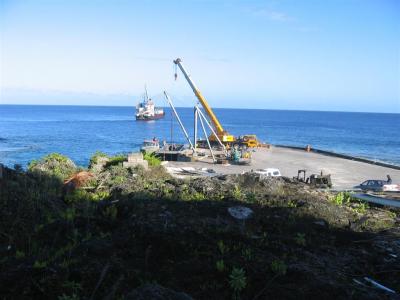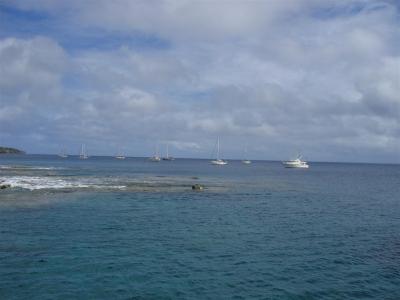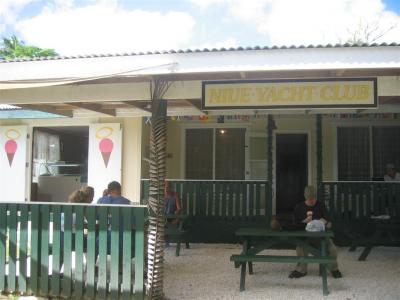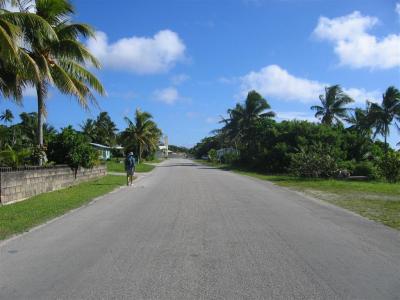19-00 S by 169-55 — Niue is the world’s smallest independent nation with only 1200 people on the island. Niue is the largest raised coral islands in the world. It is comprised of one coral limestone island that has an area of 259 square kilometers and a height of 200 feet. It is nicknamed “the rock of Polynesia”. Niue also possesses control of a sunken atoll to the south of the main island, called Beveridge Reef. Like the Cook Island’s, New Zealand is the protectorate of Niue. Even though they are under New Zealand, it is self-governing. Of all the nations, Niue has the most number of politicians per capita one per 65 people. Niue has one flight per week from New Zealand, and mail in and out goes on that flight. There are a total of 50 hotel rooms and the island can accommodate about 120 tourists at a time. Niue is a popular fishing, diving and caving spot.
Thankfully there are moorings, which are huge sunken blocks of concrete attached with a rope boats can tie to.
At around 0400, in the pitch black on a cloudy, moonless night, we heard a boat calling the 24 hour watch station for Niue, aptly named “Niue Radio”, for assistance. It was a sailboat who was trying to motor to the mooring area (conditions were poor for sailing). His engine was malfunctioning and started consuming many times the normal amount of fuel and he was quickly running out of fuel. Niue Radio said everyone was still asleep and it would take a while to get help. We were only 10 miles away from the distressed vessel, Ragnar. Eric called and offered to tow them in. Niue was relieved that there was someone close by to help him. Maritime law says if you can help, you should try to help. And of course it is good karma to help fellow boaters, you never know if you may be in need yourself. We were not about to let Ragnar drift into any rocks in the dark night. Kosmos escort to the rescue! We increased speed and changed course a bit to get closer to Ragnar as quickly as possible.
Niue Yacht Club also listens 24 hours a day, and was monitoring the situation. The yacht club handles the moorings. We were able to chat with them and discover moorings were available for both Ragnar and Kosmos. We were so relieved. Also Niue Radio asked for our pertinent information so they could begin the customs process for us.
As dawn broke, Niue was visible to the naked eye. Until then it was only pixels on the radar screen. We were only three miles away from the island itself, but the anchorage in the main town of Alofi was another 12 miles south. Being that it is one of the largest raised coral islands, we were expecting a majestic towering rock, kind of like Bora Bora. It is tall compared to an atoll, but low compared to a fringing reef island like Bora Bora or Tahaa. We don’t know why we had envisioned something super tall when we knew it was only 200 feet high.
We reached Ragnar shortly after sunrise. He told us he thought he would be able to make it to the anchorage without a tow, but he wanted help getting attached to a mooring. If he missed the line he would not be able to maneuver. So he wanted someone with a dinghy in the water to help him get the line. We were relieved we didn’t need to tow him in because towing in the open seas can be dangerous. Now it was up to the other boats to render assistance, since it takes us too long to get our dinghy down to be able to be of help. Thankfully, someone was available and Ragnar was able to get help attaching to a mooring just after we did. We called Niue Radio and let them know we had moored and that Ragnar was safe as well. Escort duty was finished.
The entire shoreline of Niue visible from the anchorage is a sheer rock cliff with no beach or coastline. It is green and lush. It smells green, lush, and fertile, the smell more dominant here than we have noticed any place since the Marquesas. There were 8 sailboats present. The water is dotted with several bright red mooring balls. Like Suwarrow, the water is so clear you can see the bottom. There is a small wharf just to the north of the mooring area. We saw that there was a large container ship loaded to the brim near the wharf, and a big crane and mack truck on the wharf awaiting the arrival of the container vessel. From the wharf there is a fairly steep road leading up the hill to town. We could see this road feeds into another road that parallels the coastline. The coastline is dotted with buildings.
Niue told us they were ready for us to come to shore to do our customs clearance. That was fast. We started going through our routine of situating the boat when they called back and told us that the container ship was about to dock at the wharf. Once it docked, the wharf would be closed to all dinghy traffic going in and out for the rest of the day. If we wanted to clear in, we needed to do it now or wait until tomorrow. Desperate to get on dry land, we deployed the dinghy in record time and rushed to shore.
The wharf is a big rectangular concrete slab with tires lining the walls. We noticed that there was a big barge going between the container vessel and the wharf. They were unloading cars into the barge, and then the crane was lifting the trucks out of the barge onto the wharf.
We headed to the wharf ready for a new experience with the dinghy. Here, you land your dinghy on a set of steps set into the slab, quite close to the area where the barge was parked. Then the different part: You get out of the dinghy and pull it over to a large crane hook dangling at the wall just beyond the stairs. You then attach to your lifting harness and walk over to the lever a few feet away and lift your dinghy out of the water onto the wharf. If you do not do this your dinghy would get bashed up on the unprotected sea wall, and with limited space on the wharf dinghies would block access. Once the dinghy is up, you need to move it several yards so it is out of the way.
Fortunately, there were several gentlemen there that helped us with the crane. As we carried the dinghy, we were so glad we had opted for lightweight dinghies. They is a clunky rolling platform you can put heavier dinghies on. We were greeted at the dock by Ernie from the yacht club, one of the people we were on the radio with earlier.
Here is the wharf from the top of the hill. The big yellow crane was for the container vessel and the barge that runs back and forth from the ship. The gray crane in front what we used to lift the dinghy.

Here is a shot of the anchorage.

The customs office was just at the top of the hill in a trailer looking building. We filled out some simple paperwork and were checked in within a few minutes. The next stop was immigration, located within the police station a few blocks down the main road. Once again, we filled out a couple of short, simple forms and we were done. We went to the bank to get some New Zealand dollars, the local money. The bank is located between the two offices in the “commercial center”. The commercial center included the bank, a small grocery store, the telecom office, the post office, the internet center, and a few retail shops.
Of course, the first and most important priority of the day was a big meal to celebrate our arrival. We went to a small café across from the police station. It overlooked the water and offered a beautiful view. The breakfast choices were mostly traditional New Zealand, which are much heartier than the small French breakfasts offered in most restaurants in French Polynesia. Our choices were spaghetti on toast, eggs and ham, shrimp omelet, or eggs, ham, sausage, and baked beans. We went for the eggs and ham and the shrimp omelet. The food wasn’t all that good, and neither was the service. But we were so happy to be on land and in a restaurant that we just didn’t care.
After breakfast we headed over to the Niue yacht club. Since they are the ones who own and maintain the moorings, so we needed to check in with them, as well. The fee is $10 New Zealand per day. We filled out another short, easy form. We also decided to join the Niue yacht club. The fee is $20 New Zealand, far more reasonable than the tens of thousands of dollars charged by some yacht clubs at home. We are officially yacht club people now. We know that the $20 would pay for itself in discounts on food and drink at other yacht clubs around the world. If anyone at home is interested in joining the Niue yacht club, they will sign you up over the internet www.niueyachtclub.com. We are the second power boat ever to join out of 1100 members, the first one being a mega yacht. What really sealed the deal was the yacht club is attached to an ice cream store stocking yummy New Zealand ice cream.

We were told that there were only three moorings that weren’t strong enough to support Kosmos’ weight, and we were on one of them. Keith told us to move to mooring one, the closest to the wharf and the strongest of all. We were already really nervous about leaving Kosmos so quickly, so this made us even more nervous.
There are three people who run the yacht club, Ernie, Keith and Jim. None of them actually have yachts. They are local volunteers that help keep the boating community alive to attract tourists. They are incredibly nice, helpful people. Keith gave us the low down on the island. He then told us to hop in the car and gave us a quick tour of Alofi, the main town in Niue. You can walk from end to end in minutes. It is reminiscent of the main town in North Fakarava, with a nice paved road lined with a mix of commercial and residential buildings. The buildings along the road are attractively landscaped.

There are a lot of empty foundation pads and a few severely damaged, uninhabited buildings. Keith explained to us that in 2004 Cyclone Heta had completely devastated Niue with 300 km per hour winds and Niue was still not completely rebuilt. The side of the street along the shore was completely built up prior to the hurricane. It seemed safe from waves 100 feet above sea level. Yet the waves crashed up that high, being pushed from the tremendous winds, and destroyed the buildings. The government isn’t allowing new construction along the shore.
After we finished our tour, we went down to the wharf to see if we could get back to Kosmos. We really wanted to move moorings and get properly situated. The container vessel was still offloading using the barge and was not yet tied to the dock, so we carried our dinghy back to the crane, lowered her down, and headed back to Kosmos.
As soon as we got back to Kosmos, we moved to mooring one. Once secured on the new mooring, we went through the usual steps to get Kosmos situated. Eric deployed the paravanes. There is no reef and no bay here, so we get a lot of swells from the ocean. Once again, we are glad we have the paravanes.
We were feeling better about leaving Kosmos. The container ship still had not pulled up to the wharf, so we headed back to shore. We went to the internet office and signed up for wi-fi at the boat. It only costs a one time $25 fee, and then you get unlimited minutes. In French Polynesia we paid for internet by the minute (and we are sure the ticker counted more minutes than we really used). We wandered through the shops in the commercial center. The shops sell an odd variety of things.
We realized we were hungry and set out in search of an open restaurant. It was 14:30 (2:30 pm), so lunch hour was over. We passed several closed restaurants before coming to an open Indian restaurant farther down the road out of town. The owner is a really nice guy. He told us that our choices were beef or lamb curry served with plain naan bread. The supply ship normally comes once a month, and it was two weeks overdue. He, like everyone else on the island, was quickly running out of everything. Keith from the yacht club had told us the same thing. We ordered one of each. It was very good.
We were both tired. We were looking forward to a solid 8 hours of sleep. We headed over to the wharf and were relieved to see that the container ship had not tied up to the wharf yet, so we could get back to Kosmos. As we were deploying the dinghy, we chatted with one of the dock workers. He said that they offload with the barge until the ship is light enough to bring to the shallow wharf, then they bring the ship in for final unloading. The ship was actually about to be pulled in within a few minutes. They would work non-stop until the ship was unloaded, then the ship would leave immediately. Talk about fortuitous timing. We would have been really bummed if we had to stay on land for most of the night. We were exhausted, and there wasn’t anything on shore to do to keep us occupied.
Almost upon arrival at Kosmos, the ship pulled up to the wharf. We watched for a bit as the crane took the containers off the ship and put them on the truck bed, then the truck would drive up the hill to unload the container at the top of the hill.
Much to our dismay, the internet didn’t work. We were in bed by 2000 (8:00 pm).

Im glad the internet didnt work. I think you needed some sleep.
Kosmos saves the day! Never underestimate the power of Karma.
Niue looks like a beautiful place to drop anchor.